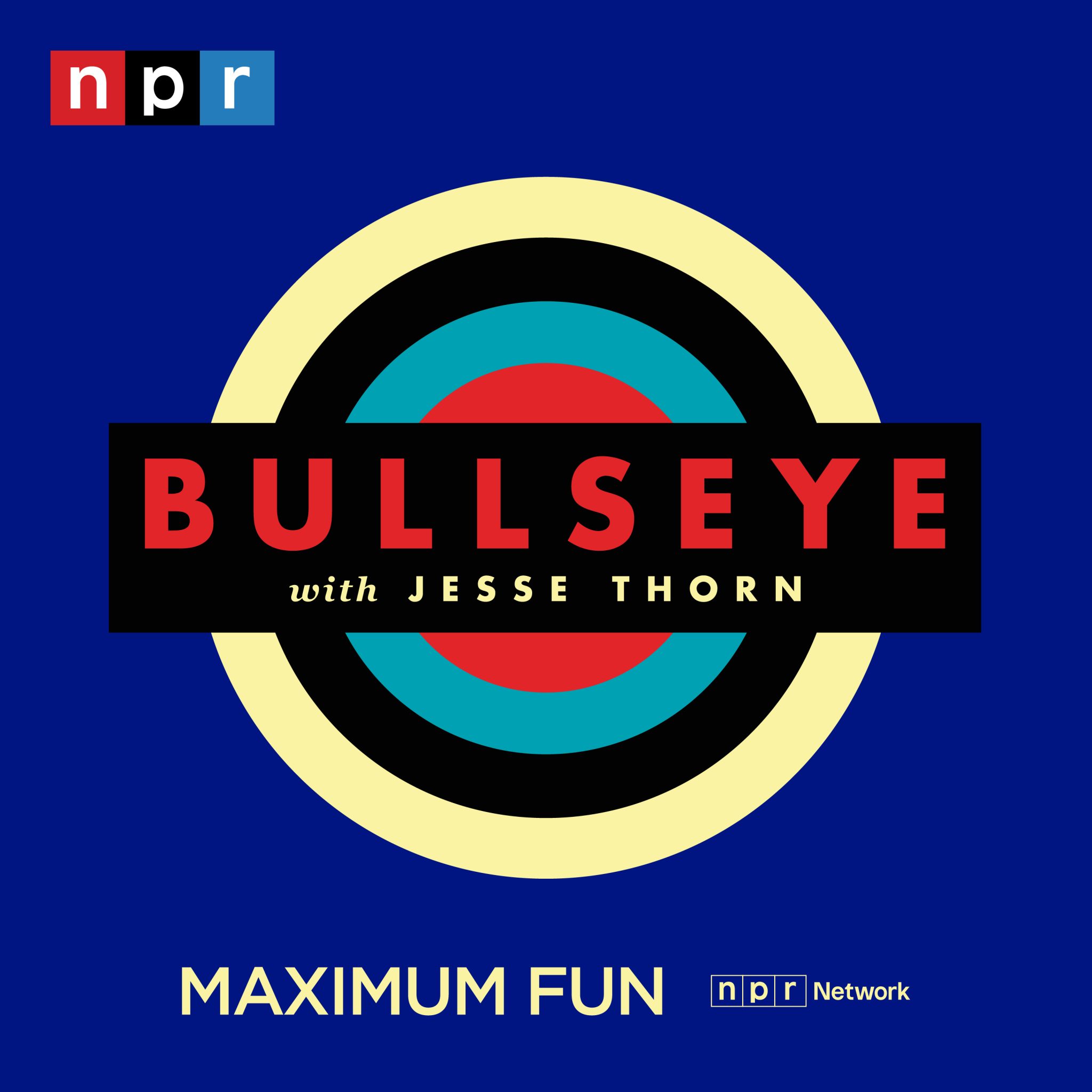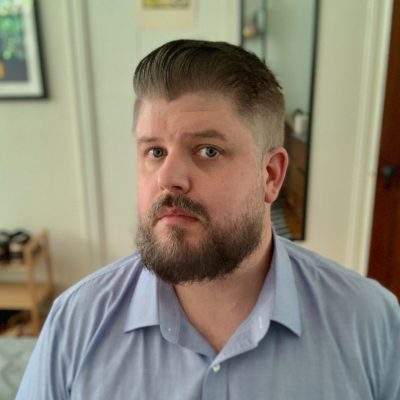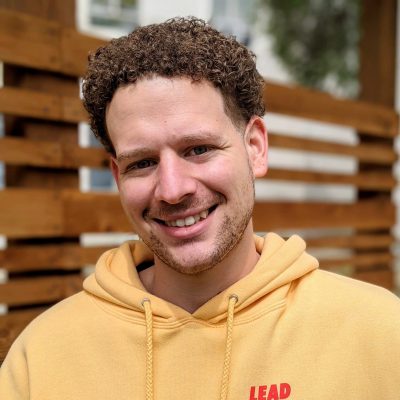Transcript
[00:00:00] Music: Gentle, trilling music with a steady drumbeat plays under the dialogue.
[00:00:01] Promo: Bullseye with Jesse Thorn is a production of MaximumFun.org and is distributed by NPR.
(Music fades out.)
[00:00:10] Jesse Thorn: It’s Bullseye. I’m Jesse Thorn. Time now for The Song That Changed My Life. It’s a segment we do with musicians who tell us about the songs that made them who they are.
(Music fades in.)
This week, it’s Devendra Banhart.
[00:00:24] Music: “We All Know” from the album Niño Rojo by Devendra Banhart.
We all know
That the wind blows
And the moon glows
And our lungs grow
(Music fades out.)
[00:00:43] Jesse Thorn: Banhart is a singer-songwriter. He grew up living in both the US and Venezuela. When he started cutting albums, it was the early 2000s. Back then, his recordings were simple. Usually a classical guitar, one mic—maybe two mics, if he was feeling elaborate—and his voice, warbling and almost ancient.
[00:01:04] Music: “The Body Breaks” from the album Rejoicing in the Hands by Devendra Banhart.
The body breaks, and the body is fine
And I’m open to yours, and I’m open to mine
The body aches, and that ache takes its time
But you’ll get over yours, and I’ll get over mine
And the sun will shine
And the moon will rise up
(Music fades out.)
[00:01:37] Jesse Thorn: Those early albums—like Niño Rojo and Rejoicing in the Hands—were hits, beloved by critics and college students everywhere. The writers lumped Banhart’s music alongside acts like Animal Collective and Joanna Newsom in a genre called freak folk. It was the early 2000s. But Banhart’s discography is hard to pin down. He’s recorded ambient music, ’60s fuzz rock, ’80s new wave, tropicalia, sometimes all of them on the same record.
[00:02:08] Music: “Carmensita” from the album Smokey Rolls Down Thunder Canyon by Devendra Banhart.
Ay tu primo Colorado
Con barba camburada
Y lleno de ballena inclinándose al sol
Tu rayo de luz roja
Besando nuestra boca
El beso que…
(Music fades out.)
[00:02:21] Jesse Thorn: Banhart’s latest album is Flying Wig. Here’s a single from it, “Sirens”.
[00:02:25] Music: “Sirens” from the album Flying Wig by Devendra Banhart.
It’s getting harder to sing impossible things
I ran away from the place where I stand
It’s getting harder to say…
(Music fades out.)
[00:03:09] Jesse Thorn: When we asked Banhart about the song that changed his life, he took us back to his childhood in Venezuela. He picked a song from one of that country’s greats, Simón Díaz. Here’s Devendra.
[00:03:19] Devendra Banhart: Hi, my name is Devendra Banhart. This is a song called “Guillermina” by Simón Díaz, and it’s a song that changed my life.
[00:03:29] Music: “Gillermina” from Tonadas Vol. 2 by Simón Díaz.
Pusieron preso a tu marido, Guillermina
Pusieron preso a tu marido, Guillermina
(Music continues under the dialogue.)
[00:03:43] Devendra Banhart: Well, you know, I grew up with Simón Díaz in Venezuela. He’s a ubiquitous figure. You know, he’s a cultural icon. You grew up seeing him on TV. I was so little that I don’t know the name of any of the shows, but I don’t think there was a moment when I didn’t see him on TV doing something.
And we love a variety show there. The long-standing variety show that everyone in Venezuela of my generation grew up watching was called Sábado Sensacional—Sensational Saturday.
[00:04:20] Clip:
Music: Exciting, brassy music.
Announcer: En Súper Sábado Sensacional!
(Applause.)
Host: Símon, quien fue essuperastro Americano que a su estilo llevó caballo viejo por todo mundo?
(Simón Díaz sings an upbeat tune.)
Ray Conniff! Okay vamos a ver este video. Su esposa y su hija cantando “Caballo Viejo”!
Que lindo video clip!
(Music fades in.)
[00:04:53] Devendra Banhart: You know, he’s known as Uncle Simon. That kind of reach and that kind of, you know, familiarity. You know, he feels really like a family member for, I think, most Venezuelans of a particular generation. He’s on the, you know, cereal boxes. You know, he’s our first kind of celebrity cultural identity. You know, it’s kind of—so, he’s—I didn’t even know he was a musician until I lived in America. He was just this guy you see around.
You’re going to hear Simón Díaz walking down the street. It’s as ubiquitous as salsa and cumbia and merengue. But you’re not going to hear this song. Even though Simón doesn’t have this one type of song. There’s a happy party song.
[00:05:38] Music: “El Gavilan” by Simón Díaz.
(Music fades out.)
[00:05:46] Devendra Banhart: There’s a really minimal and spacious, even avantgarde kind of spoken word kind of song.
[00:05:54] Music: “Contrapunteo” by Simón Díaz.
Este es una faena que hacemos en el llano antes semana Santa y consiste en sacar unos Galápagos de unos cañones que quedan después de las inundaciones de la Sabana…
(Music fades out.)
[00:06:06] Devendra Banhart: There’s the classic tonadas, which are these laments that are woeful. This kind of—the spooky, ghost Simón, which is the early tonadas. You know, the “Tonada de Luna Llena”.
[00:06:16] Music: “Tonada de Luna Llena” from the album Sus grandes éxitos by Simón Díaz.
Luna, luna, luna llena menguante
Anda muchacho a la casa
Y me traes la carabina, jio
(Music fades out.)
[00:06:39] Devendra Banhart: There’s a whole kind of range of moods and emotions that his career contains. Even though there’s this entire prism of emotions within his career, there really isn’t a song like this one. This one feels like an outlier.
[00:06:58] Music: “Guillermina” by Simón Díaz.
Pusieron preso a tu marido, Guillermina
Pusieron preso a tu marido, Guillermina
(Music continues under the dialogue.)
[00:00:00] Devendra Banhart: So, Guillermina is Wilhelmina. It’s a woman’s name, and the first line is, “Pusieron preso a tu marido, Guillermina.” “They imprisoned your husband, Guillermina.”
[00:07:26] Music:
Y se lo llevaron a una fuerte prisión
Y como Guillermina quería tanto a su marido
Fue a la cárcel a cantarle una canción
Fue a la cárcel a cantarle una canción
(Music continues under the dialogue.)
[00:07:52] Devendra Banhart: And they took him to a very well-guarded prison, let’s say. So, they didn’t take him just to prison; they took him to a really gnarly prison. “Pero como Guillermina quería tanto a su marido—” “But because Guillermina loved her husband so much—”
(Speaking in time with the music in the background.) “Fue a la cárcel a cantarle una canción.” “She would go to jail and sing to him.” Really, “She went to jail and sang to him.” Already there’s a whole movie there. There’s so much—there’s so much there. It paints such a picture of devotion and loneliness and heartbreak.
[00:08:33] Music:
Pusieron preso a tu marido, Guillermina
Pusieron preso a tu marido, Guillermina
Y se lo llevaron a una fuerte prisión
(Music continues under the dialogue.)
[00:08:51] Devendra Banhart: The music is kind of lilting you along, carrying you through that kind of scene. It’s very cinematic. Just that there—okay, there’s that scene.
[00:09:01] Music:
Murió mi madre y yo estaba ausente
Murió mi madre y yo estaba ausente
Yo ausente estaba, no la vi
Pero me dice mi padre que en su agonía de muerte
Alzó su mano y me bendijo a mí
Alzó su mano y me bendijo a mí
(Music continues under the dialogue.)
[00:09:37] Devendra Banhart: Next, “Murió mi madre y yo estaba ausente.”—“My mother died, and I wasn’t there.”
“Pero me dice mi padre que en su agonía de muerte…”—“But my father told me that in the agony of her death throws…”
“Alzó su mano y me bendijo a mí.”—“She raised her hand and blessed me.”
You know, why wasn’t he there and what was going on? And it’s just so—already also an entire film exists there. Who knows! But it sounds like “she blessed me” could also be like “she forgave me”. You know, behind the blessing, I think that the longing is to be forgiven. You know, that seems more—that could be the subtext of that line.
(Sighs.) It’s so beautiful. It’s so heartbreaking, so heartbreaking.
[00:10:26] Music:
… que está al llegar
Niña que bordas la blanca tela
Niña que bordas la blanca tela
Niña que tejes en tu telar
Bórdame el mapa de Venezuela
(Music continues under the dialogue.)
[00:10:55] Devendra Banhart: So, the last stanza is, “Niña que bordas la blanca tela, Niña que tejes en tu telar. Bórdame el mapa de Venezuela. Y un pañuelito para llorar.” So, basically he’s saying, “This person who works with cloth in their workshop, will you please embroider the silhouette”—the map, actually. Embroider the whole map of Venezuela. I don’t know why I said silhouette. I imagined it was silhouette, but he’s saying “bórdame el mapa de Venezuela”. That’s interesting. “Embroider the map of Venezuela on a little handkerchief for me to cry into.”
In a way, it feels like he’s lamenting what’s happened to his country, because of the mismanagement of the government and the corruption of the government. I don’t know—untreated anger that leads to violence and—(sighs). Yeah, I think he’s really weeping for the whole country and what’s happened to it through this song.
[00:11:54] Music:
Y un pañuelito para llorar
Y un pañuelito para llorar
(Music ends.)
[00:12:14] Devendra Banhart: Maybe it’s about “I’m not there, and I miss it so much”. Maybe it’s a direct way of saying “I’m weeping for this country—literally. So literally, I’m weeping into the country. You know, I need this handkerchief.”
You know, so it’s even more oblique. And then actually what seems explicit is actually even more hidden, what he’s really trying to say about the country. There’s also this literal stuff happening. I’m crying into the thing. Oh man, it just really blows my mind! And he has sad songs, for sure. He has sad songs. But this has such a—I don’t know, maybe none of them are as explicitly woeful as this one. To me at least.
[00:13:17] Music: “Guillermina” covered by Devendra Banhart.
Niña del campo que corta flores
Niña del campo que corta flores
De no me olvides y de azar
(Music fades out.)
[00:13:19] Devendra Banhart: When I perform this song, it’s a real drag, because I don’t want to (censor beep) the lyrics. Doing covers is so perilous for me, because I don’t mind if I mess up with my lyrics. I forget them all the time. We just played a show, and I’ve played this one song 1,000—more than 1,000 times! I’ve been playing it for 20 years! I got the first line. Next one? Noooo idea what it is, so I just kept repeating the first line. Then I kind of mumble something, maybe make something new up, okay, eventually remember it. That doesn’t really flow or fly so well when you’re doing a cover. You really want to honor the song.
So, that’s a moment where we get to—we’re really expressing gratitude and trying—and that’s the most focused moment, usually, in our sets. Because we are really in a communal kind of place. That’s one of the things that we long for. You know, we long for ritual. And music has this. Especially a live performance has all these three things that are so important. Community, ritual, and healing. And you know, a live performance can have that. And by healing, I mean where else are you going to be weeping other than at a funeral or at a movie? At a show, you can communally weep. And of course, this is very healing. And so, I get to have that moment with these people that I love so much, celebrating this person who means so much to me. So, this is my answer to—that’s why I’m playing this song. It’s still a drag though. (Laughs.)
[00:14:45] Music: “Guillermina” by Simón Díaz.
Pusieron preso a tu marido, Guillermina
Pusieron preso a tu marido, Guillermina
(Music continues under the dialogue.)
[00:15:02] Devendra Banhart: Through the years, I thought about other songs that I maybe would talk about today. But this one—this one reminded me that I’ve spent so much of my life feeling like a Venezuelan in America or an American in Venezuela. You know, when I’m there, I’m an American. When I’m here, I’m Venezuelan. And I feel there’s that disconnect from my ancestry. You know, I feel disconnected from my ancestry.
And hearing this song—when I first discovered this song, it felt like the kind of songs that I want to write. It was the kind of music that I want to write and the kind of things that I want to have someone sing to me. I felt like this is my kind of thing. And so, it connected me with something much deeper than, you know, a family member. It connected me with the kind of the spirit of this country that I grew up in and my family is from. And so, it felt like an heirloom being—I felt like I had possession of an heirloom, the way that I’m wearing my grandmother’s ring on my pinky and her earrings right now. This song felt like an ornament. You know, I identified so much with that song—as opposed to having a culture imposed upon you. You can’t avoid certain types of music walking down the street there. It’s a very musical place. It’s amazing! It’s beautiful!
But this was like discovering something that was just mine. So, that’s how it changed my life.
[00:16:27] Music:
… de dos colores
Para mi amada que está al llegar
Para mi amada que está al llegar
(Music fades out.)
[00:16:39] Jesse Thorn: Devendra Banhart on the song that changed his life, “Guillermina” by Simón Díaz. Banhart is in the midst of a massive, worldwide tour in support of his newest album, Flying Wig. Let’s hear one more song from it. This is “Twin”.
[00:16:54] Music: “Twin” from the album Flying Wig by Devendra Banhart.
Same face to face
Same face to face
Same desolate space
Same desolate space…
(Music continues under the dialogue.)
[00:17:37] Jesse Thorn: That’s the end of another episode of Bullseye. Bullseye is created from the homes of me and the staff of Maximum Fun, in and around greater Los Angeles, California. You won’t be surprised to learn that when there was a storm in Los Angeles the other day, a bunch of huge branches fell out of the big old tree outside of my house. I can see them there like stacked up in the street right now.
The show is produced by speaking into microphones. Our senior producer is Kevin Ferguson. Our producers, Jesus Ambrosio and Richard Robey. Our production fellow at Maximum Fun, Bryanna Paz. We get booking help from Mara Davis. Our interstitial music is by Dan Wally, DJW. Our theme song is “Huddle Formation”. It was written and recorded by The Go! Team. Thanks to The Go! Team. Thanks to Memphis Industries, their label, for providing it to us.
Bullseye is on Instagram. We’re sharing interview highlights, behind the scenes looks, and more. We’re @BullseyeWithJesseThorn. You can also find us on Twitter, YouTube, and Facebook.
I think that’s about it. Just remember, all great radio hosts have a signature signoff.
[00:18:42] Promo: Bullseye with Jesse Thorn is a production of MaximumFun.org and is distributed by NPR.
(Music ends.)
About the show
Bullseye is a celebration of the best of arts and culture in public radio form. Host Jesse Thorn sifts the wheat from the chaff to bring you in-depth interviews with the most revered and revolutionary minds in our culture.
Bullseye has been featured in Time, The New York Times, GQ and McSweeney’s, which called it “the kind of show people listen to in a more perfect world.” Since April 2013, the show has been distributed by NPR.
If you would like to pitch a guest for Bullseye, please CLICK HERE. You can also follow Bullseye on Twitter, YouTube, and Facebook. For more about Bullseye and to see a list of stations that carry it, please click here.
Get in touch with the show
People
How to listen
Stream or download episodes directly from our website, or listen via your favorite podcatcher!





